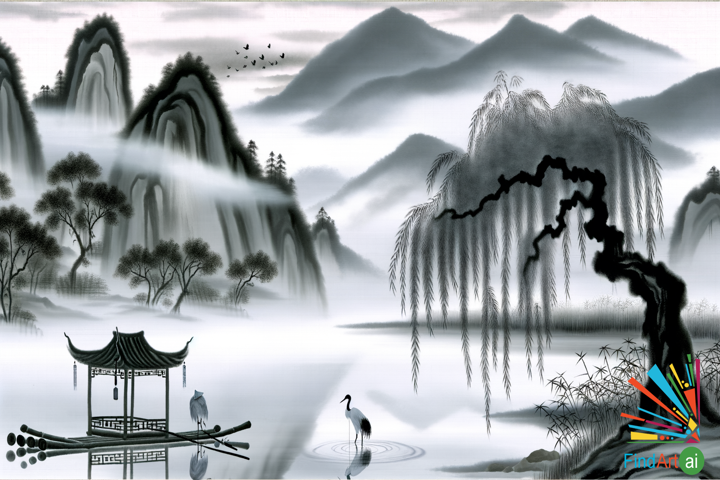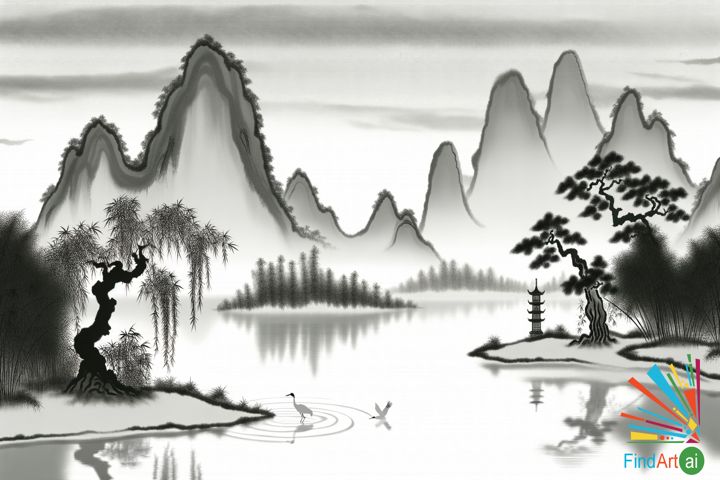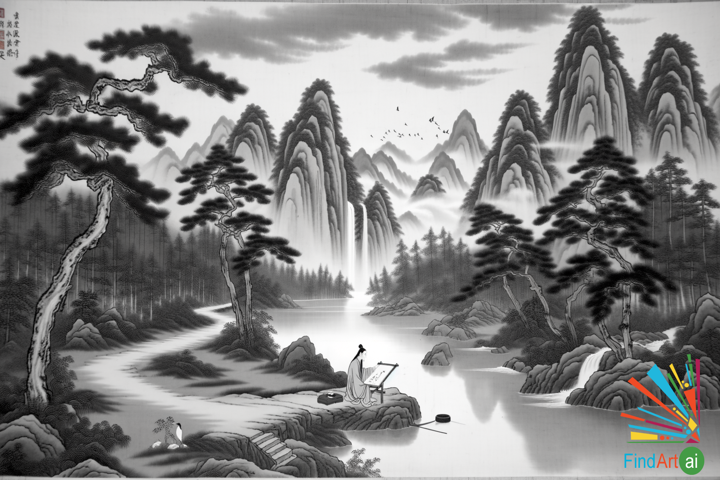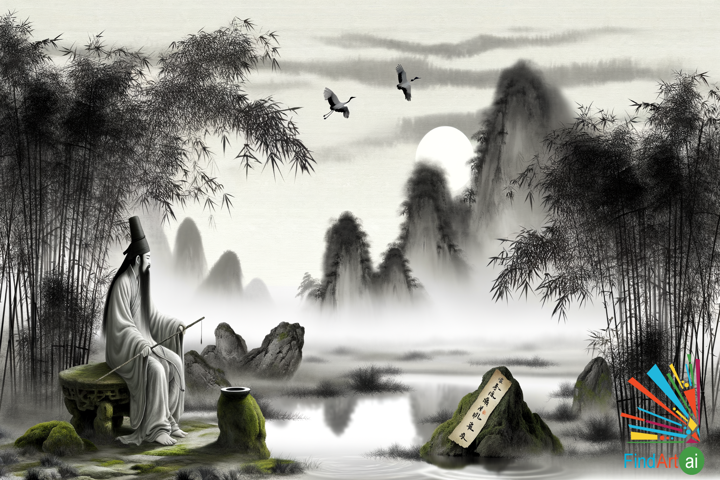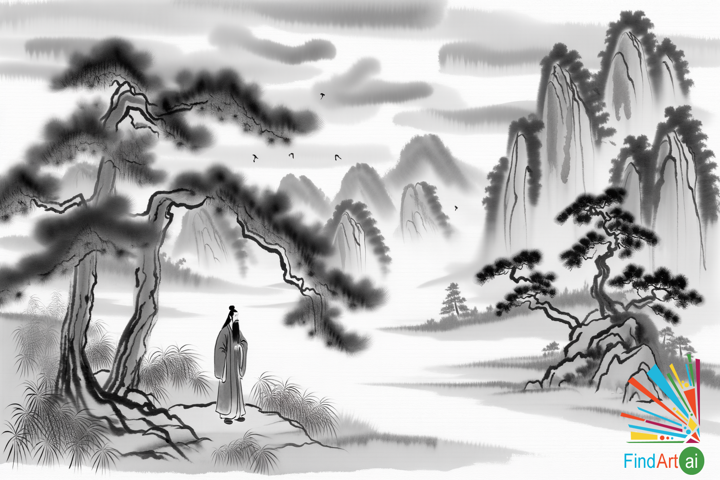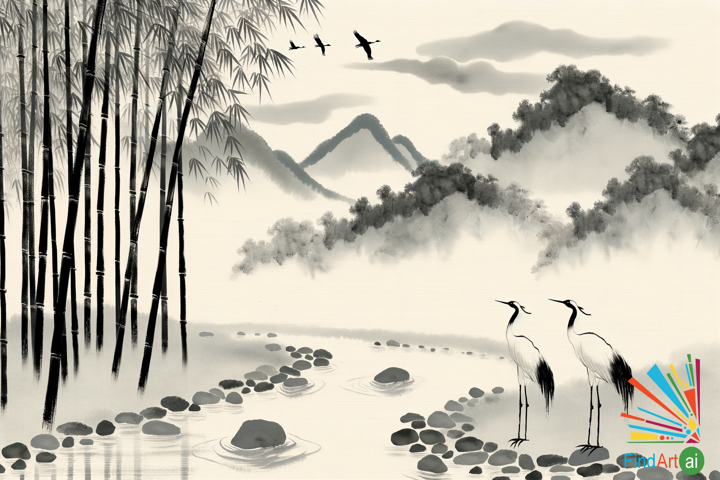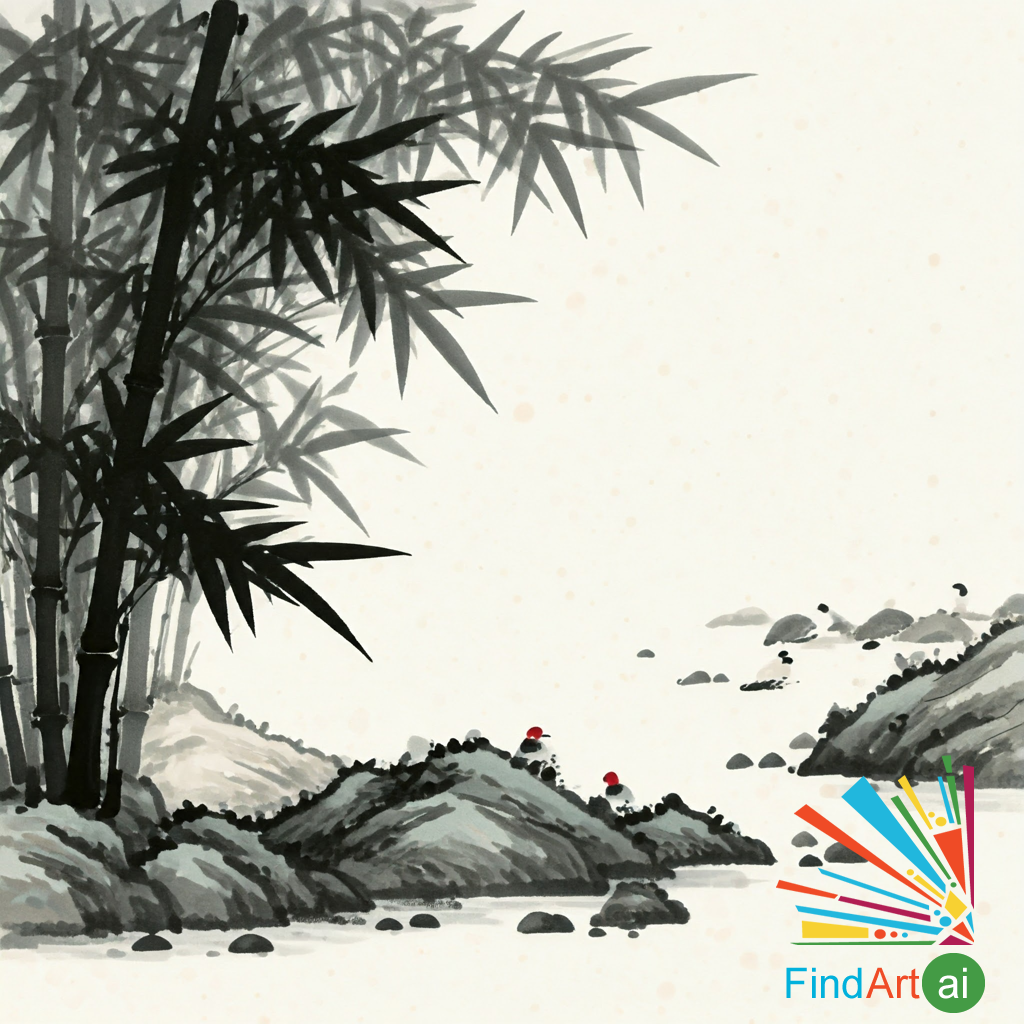
Chinese Ink Paintings with Harmony with Nature Theme
Chinese Ink Paintings with the Harmony with Nature theme are deeply rooted in traditional Chinese philosophy, particularly Daoism and Confucianism, which emphasize the harmonious relationship between humans and the natural world. These paintings often depict landscapes, plants, animals, and natural elements in a way that reflects the interconnectedness of all living things. The use of ink, with its fluidity and simplicity, is key to capturing the essence and spirit of nature rather than just its physical form. The paintings express an appreciation for nature’s beauty, balance, and the underlying forces that shape the universe.
Key Characteristics of Chinese Ink Paintings with the Harmony with Nature Theme
- Minimalist Brushstrokes and Fluidity
- Chinese ink painting focuses on capturing the spirit of the subject with minimal brushstrokes, conveying a sense of natural flow and effortless beauty. The fluidity of ink symbolizes the dynamic yet harmonious movement of natural elements like water, wind, and clouds.
- Example: A painting might depict a bamboo grove with a few bold strokes of black ink, using negative space to suggest the air and the atmosphere surrounding the bamboo, emphasizing its flexibility and resilience.
- Emphasis on Landscapes (Shan Shui)
- The "shan shui" (mountain-water) painting style is a hallmark of Chinese ink art. It emphasizes landscapes with towering mountains, flowing rivers, and misty skies. These elements symbolize the natural balance of opposing forces (yin and yang) and reflect humanity’s small place within the grandeur of nature.
- Example: A typical landscape might show a rugged mountain range rising out of swirling mist, with a single human figure or a small dwelling nestled at the base, signifying the harmony between human existence and nature’s vastness.
- Philosophical and Spiritual Depth
- Chinese ink paintings often convey deep philosophical messages about the balance between humans and nature, influenced by Daoist ideas of simplicity, balance, and unity with the natural world. Rather than merely reproducing nature, the artist seeks to reveal its inner essence and spiritual energy (qi).
- Example: A painting of an old pine tree, with its gnarled trunk and deep roots, may symbolize endurance and wisdom, reflecting the Daoist reverence for nature as a teacher and a source of spiritual insight.
- Use of Negative Space
- Negative space, or the "unpainted" areas of the paper, plays a crucial role in Chinese ink paintings. It represents the unseen, the void, or the breath of nature, and is as important as the painted elements in creating balance and harmony within the composition.
- Example: In a painting of lotus flowers, much of the canvas may be left blank, with only a few ink strokes depicting the flowers and leaves. The empty space suggests the presence of water, air, and the vastness of the natural environment, creating a serene and meditative effect.
- Depiction of Natural Elements as Metaphors
- Natural elements in Chinese ink paintings are often symbolic, representing broader themes such as resilience, purity, or the cyclical nature of life. For example, bamboo is a symbol of flexibility and strength, while the plum blossom represents perseverance through hardship.
- Example: A painting of a crane flying over a pine tree might symbolize longevity and spiritual ascent, combining the enduring nature of the pine tree with the graceful flight of the crane, both revered in Chinese culture.
- Harmony of Humans and Nature
- In many Chinese ink paintings, human figures are depicted as small and integrated within the natural environment, suggesting humility and the ideal of living in harmony with nature rather than dominating it.
- Example: A tiny fisherman on a boat floating down a vast river might represent the ideal of a simple, peaceful life that flows in sync with the rhythms of nature.
- Monochromatic Palette
- The traditional monochromatic palette of black ink on white paper reflects simplicity and subtlety. By using varying shades of black and gray, artists can evoke the texture and depth of natural landscapes, from dense forests to misty mountains, while maintaining a sense of calm and balance.
- Example: A painting might show a dense forest with layers of different grays, where each tree is represented with varying degrees of ink, creating a soft, atmospheric effect that draws the viewer into a quiet, contemplative space.
- Dynamic Interaction of Yin and Yang
- The interplay between solid (yang) and empty (yin) forms in Chinese ink paintings mirrors the Daoist belief in the balance of opposing forces in nature. This duality is often reflected in the contrast between inked and uninked areas, light and shadow, or mountain and water.
- Example: A landscape showing rugged mountains (yang) juxtaposed with flowing rivers (yin) embodies the balance between strength and softness, permanence and fluidity.
Common Themes in Chinese Ink Paintings with Harmony with Nature
- Solitude and Reflection
- Many Chinese ink paintings evoke a sense of solitude and quiet reflection, inviting the viewer to contemplate their place in the natural world. The vastness of the landscapes and the smallness of human figures within them emphasize the philosophical idea of unity with nature.
- Example: A painting of a lone scholar gazing out at a vast landscape of mountains and rivers suggests the scholar’s meditative connection to nature, where wisdom and tranquility are found in quiet observation.
- Seasonal Changes and the Cycles of Nature
- The cyclical nature of the seasons is often reflected in Chinese ink paintings, with different elements representing the changing phases of life. Spring might be symbolized by blooming flowers, while winter is depicted through barren trees or snow-covered landscapes.
- Example: A winter scene with a solitary plum tree blossoming in the snow conveys resilience and renewal, symbolizing the beauty of life emerging even in difficult conditions.
- Balance and Tranquility
- Balance and tranquility are central themes, with the natural elements in the painting arranged in a harmonious, peaceful composition. The simplicity of the brushwork and the subtle gradations of ink contribute to the overall sense of calm and balance.
- Example: A painting of a still lake surrounded by mountains, with soft reflections in the water, evokes a serene and balanced scene, reflecting the Daoist ideal of inner and outer harmony.
Whispers of Tranquility: Dawn at a Misty Riverside in Harmony with Nature and Humanity
"Whispers of Tranquility" invites viewers to a serene Chinese ink painting where nature and humanity...
Whispers of Tranquility: Serene Chinese Ink Landscape with River, Mountains, and Cranes
"Whispers of Tranquility" captures a serene landscape through Chinese ink painting, depicting a gent...
Whispering Pines: Embracing Nature's Harmony in a Serene Valley at Dawn
"Whispering Pines: Harmony with Nature" is a Chinese ink painting depicting serene unity between hum...
Tranquil Morning: A Scholar's Meditation in a Misty Valley Inspired by Chinese Ink Art
"Harmony's Embrace" depicts a serene morning in a misty valley, mirroring a traditional Chinese ink ...
Whispering Pines: A Dance with Nature - Serenity in Chinese Ink Art
"Whispering Pines: A Dance with Nature" captures the serene essence of a Chinese ink painting, featu...
Whispers of Tranquil Unity: Harmony with Nature in Serene Chinese Ink Painting
"Whispers of Tranquil Unity" captures a serene Chinese ink painting embodying "Harmony with Nature."...

